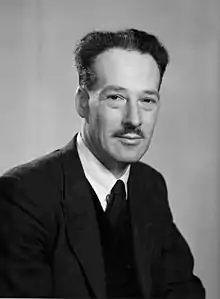Harry Fensom
Harry William Fensom (4 February 1921 – 1 November 2010) was an English electronic engineer with the GPO. During World War II he worked with Tommy Flowers at Bletchley Park on Colossus, the world's first electronic computer, that helped to decode encrypted German messages using the Lorenz cipher. After the war, he worked on ERNIE, a machine based on Colossus engineering that was used to generate bond numbers for the Premium Bond draw.[1][2]
Harry William Fensom | |
|---|---|
 Fensom around the time he worked at Bletchley Park | |
| Born | 4 February 1921 |
| Died | 1 November 2010 (aged 89) Felixstowe, United Kingdom |
| Occupation | Electronic Engineer |
| Known for | Worked on Colossus at Bletchley Park |
Early life and education
Fensom was born in Catford, in South London. Shortly after his birth the family moved to Fife, where they stayed until 1928. His secondary education was at the Royal Liberty School in Gidea Park where he excelled in mathematics and the sciences. He left school at 16, shunning a university education in favour of finding work. Whilst working for the GPO as an engineer, Fensom continued his education at night school, studying for City and Guilds at East Ham, Borough and Northampton polytechnics.[3]
World War II
In 1942, Fensom was sent to work at Dollis Hill Research Station with Tommy Flowers, Sidney Broadhurst and William Chandler. He began working on projects connected to the Enigma machine. Other projects included the Nightingale, the Tunny and the Heath Robinson.[4] Fensom's work took him increasingly to Bletchley Park and in December 1943 the first Colossus machine was installed at Bletchley Park to decode the messages from the Lorenz machine. The Mark II Colossus was installed on 1 June 1944 in time for the D-day landings on 6 June. By the end of the war there were ten functioning Colossi working around the clock helping to decipher the messages of German High Command. The deciphered messages provided the Allies with crucial intelligence on what enemy armed forces were plotting. The allies knew for example that Hitler had swallowed the bait that the D-Day landings in June 1944 would be at Calais rather than Normandy. This gave the Allies a decisive advantage.[5][6][7][8]
Sir Harry Hinsley, as the official historian, in his book 'British Intelligence in the Second World War[9]' gave his opinion that the breaking of the Enigma and Lorenz codes shortened the war by at least two years and saved hundreds of thousands of lives.
Post war activity
After the war, Fensom continued to work for the GPO at Dollis Hill. In 1957 he was given charge by Sydney Broadhurst of the system design of a machine called ERNIE, which was to be used to deliver the winning numbers of the prizes for the Premium Bonds.[10][11]
References
- "Harry - one of the few". The Telegraph. 2000-09-07. Retrieved 2018-04-11.
- "Bletchley's code-cracking Colossus". BBC News. 2010-02-02. Retrieved 2018-04-11.
- Good, Irving John; Michie, Donald; Timms, Geoffrey (2015). Breaking Teleprinter Ciphers at Bletchley Park. John Wiley. p. 550. ISBN 978-0-470-46589-9.
- Copeland, Jack (2006). Colossus: The Secrets of Bletchley Park's Code-breaking Computers. Oxford University Press. pp. xiii. ISBN 978-0-19-284055-4.
- "First-Hand:Bletchley Park, Station X - Memories of a Colossus Operator - Engineering and Technology History Wiki". ethw.org. Retrieved 2018-01-22.
- Copeland, Jack (2006). Colossus: The Secrets of Bletchley Park's Code-breaking Computers. Oxford University Press. pp. 78–83. ISBN 978-0-19-284055-4.
- Briggs, Asa (2011). Secret Days: Code-breaking in Bletchley Park. Frontline Books. p. 98. ISBN 978-1-84832-615-6.
- Fleming, Stephen. "Veterans recall D-Day at Colossus at 75 celebration". The National Museum of Computing. Retrieved 7 June 2019.
- Hinsley, Francis Harry (1993). BRITISH INTELLIGENCE IN THE SECOND WORLD WAR. HMSO, London, UK. ISBN 978-0-11-630956-3.
- "ERNIE | NS&I". www.nsandi.com. Retrieved 2018-01-22.
- "Premium Bonds at 60 - the Colossus connection". The National Museum of Computing. 2017-05-16. Retrieved 2018-04-21.